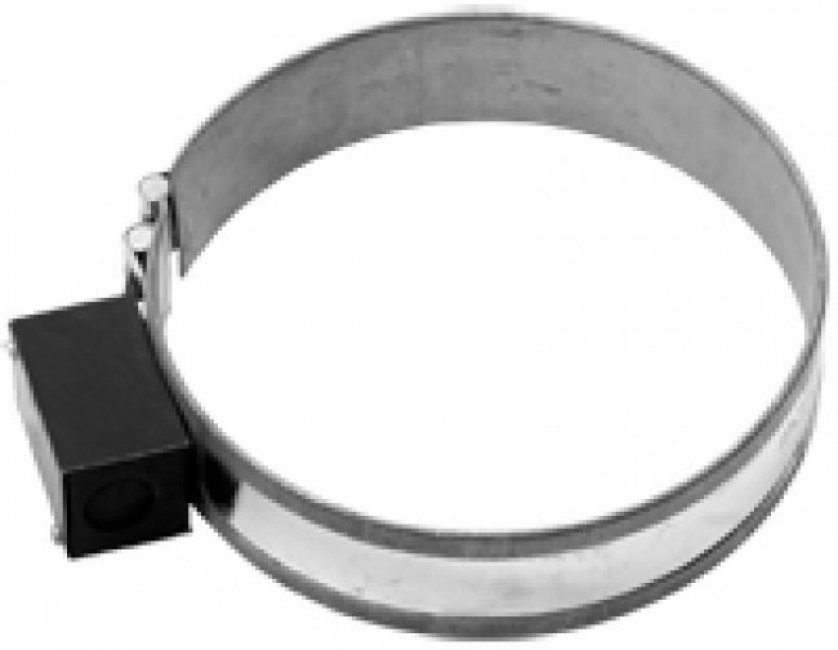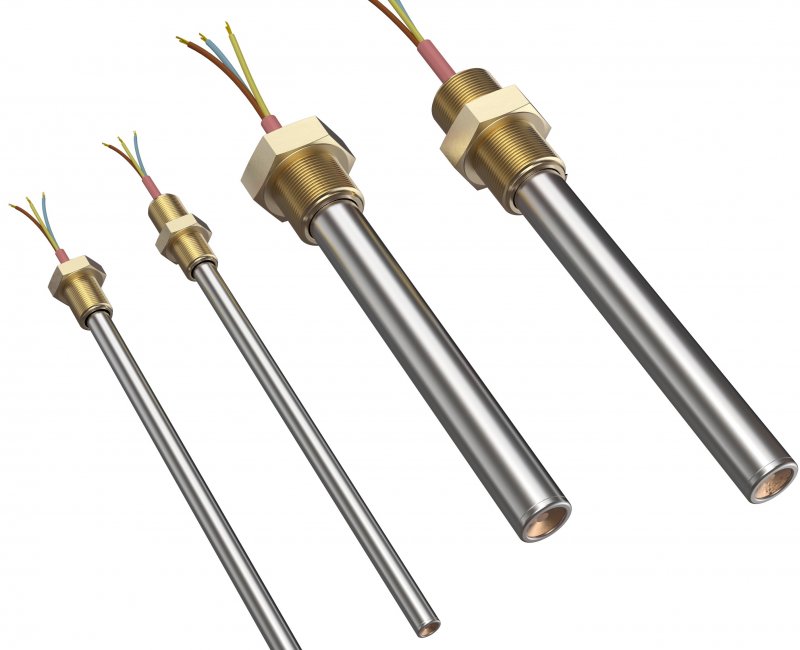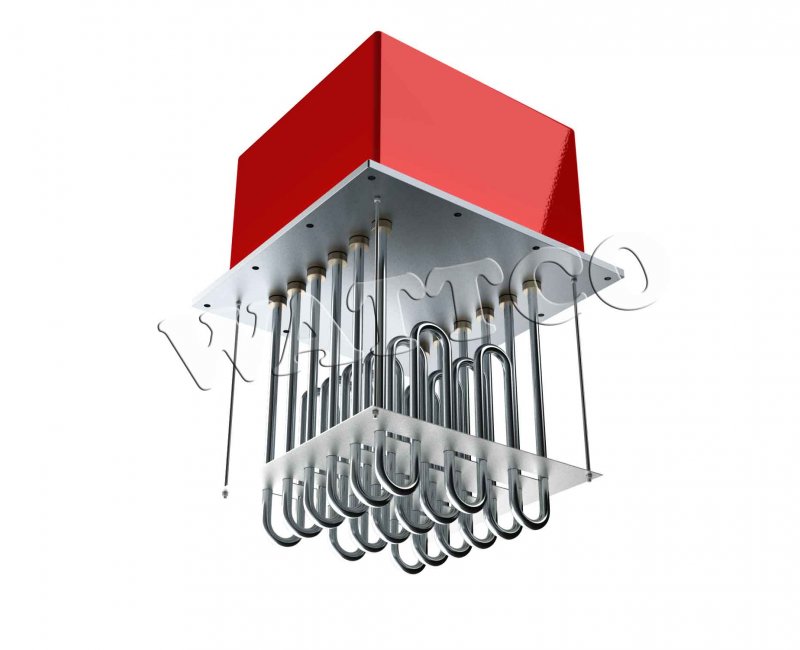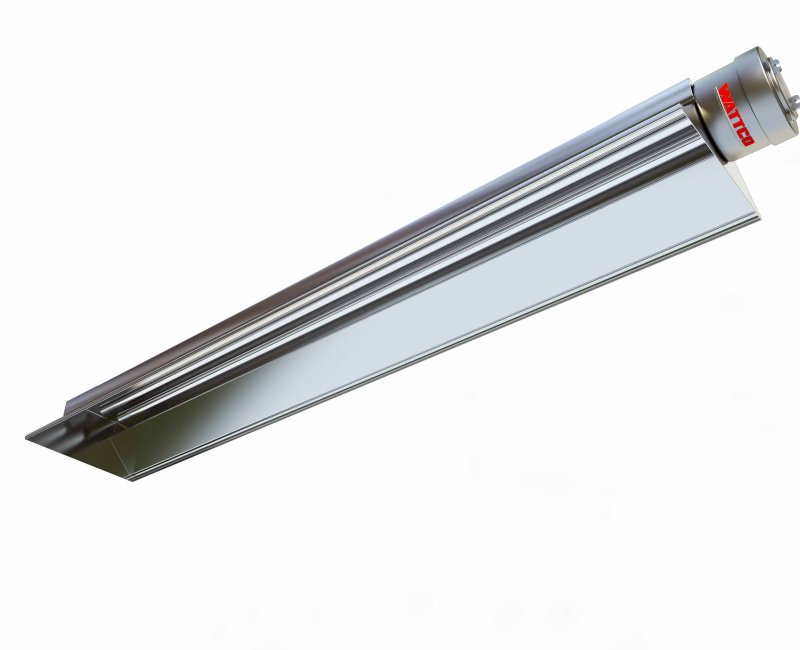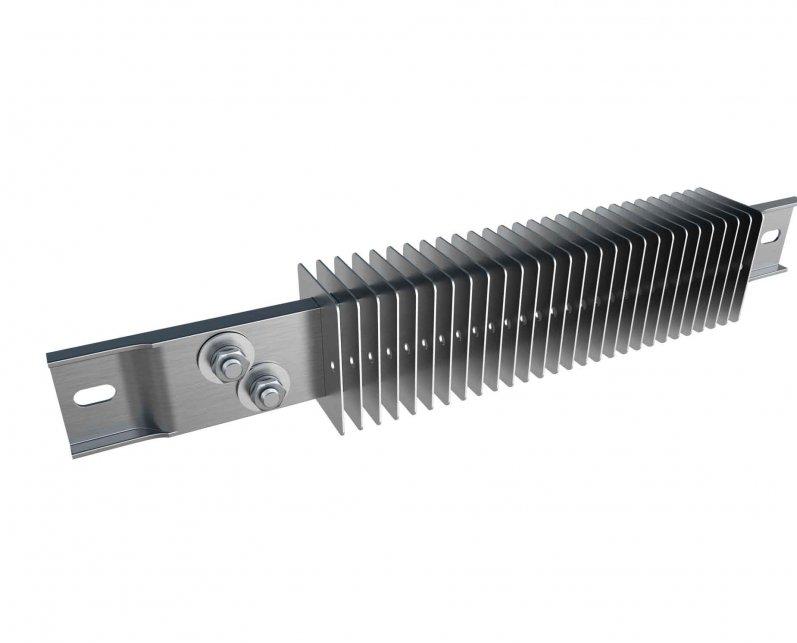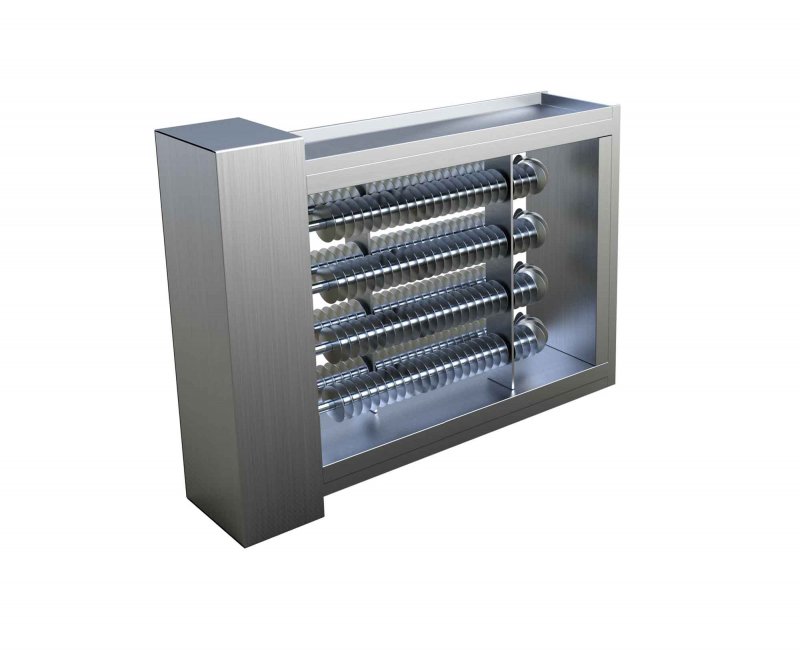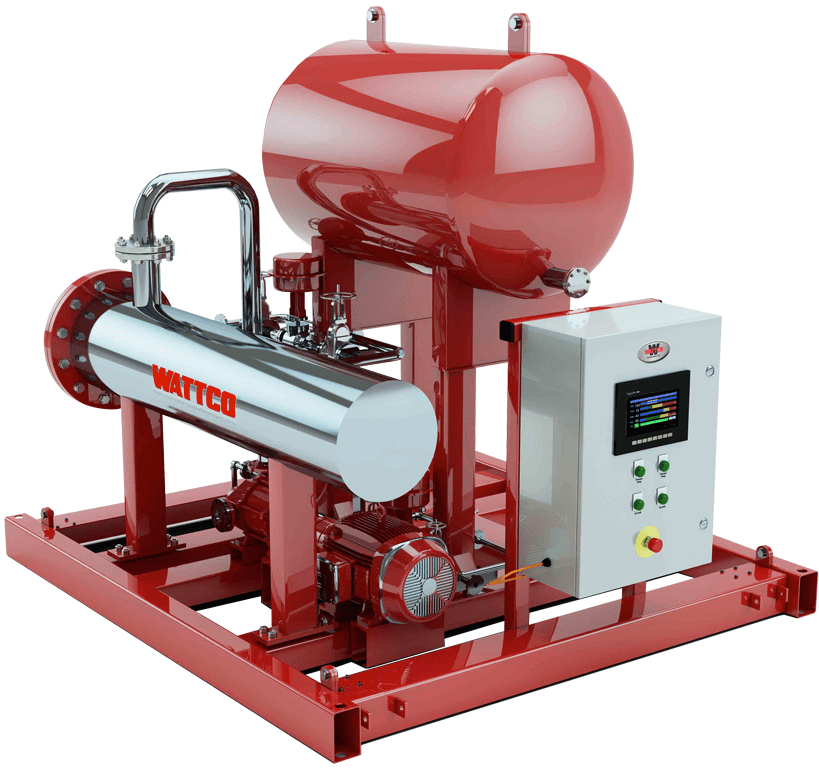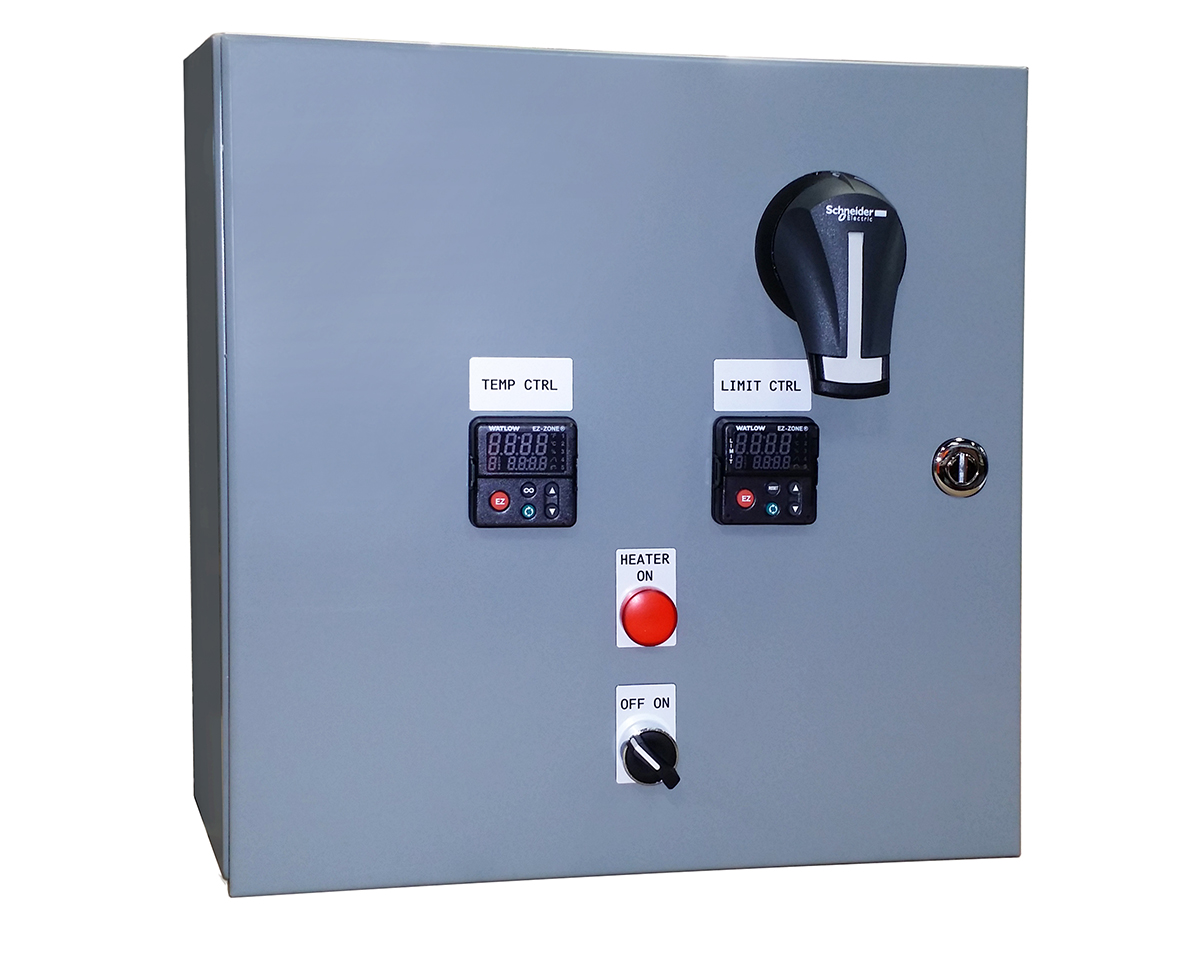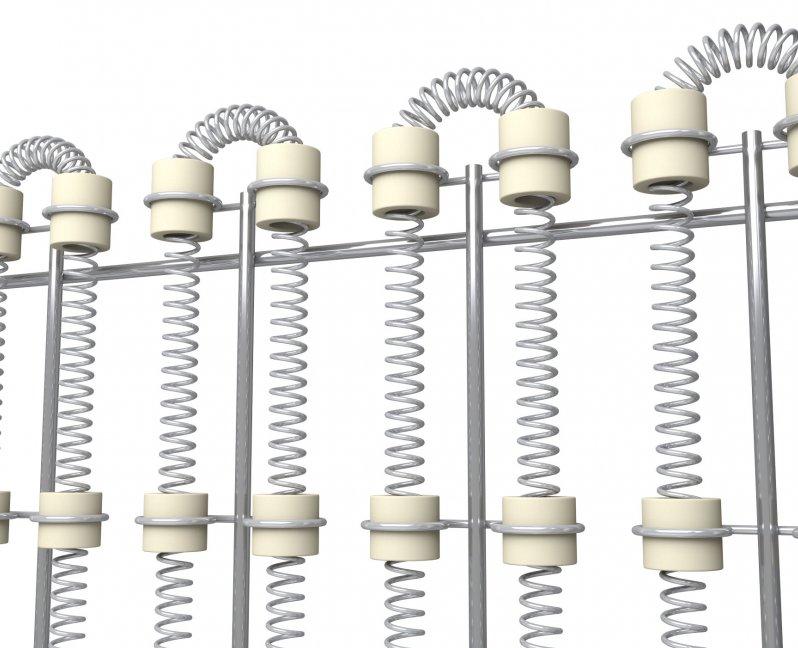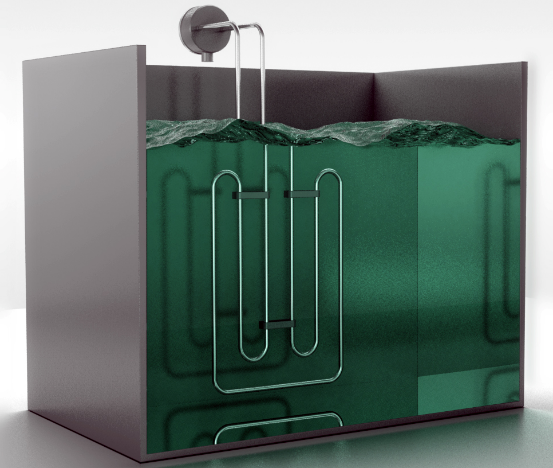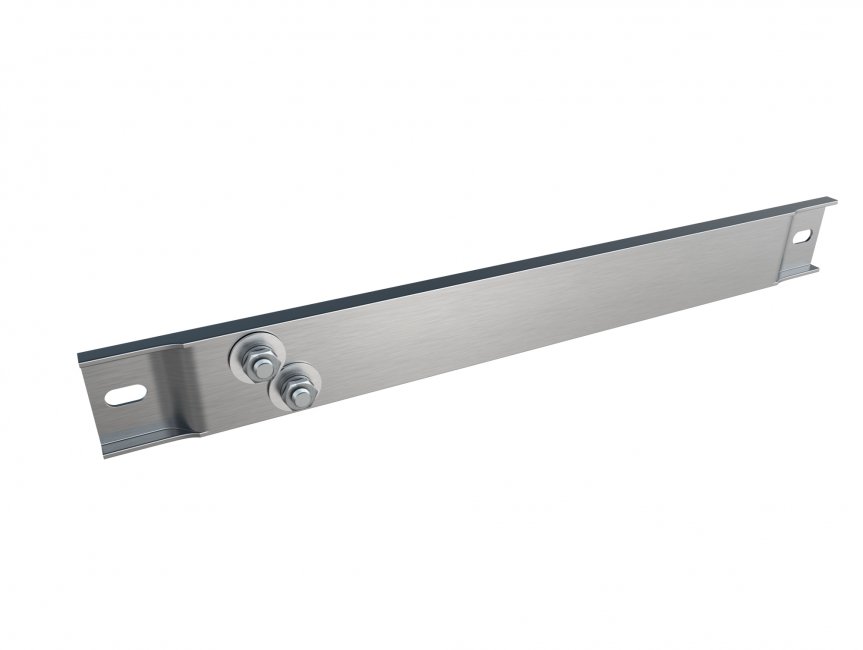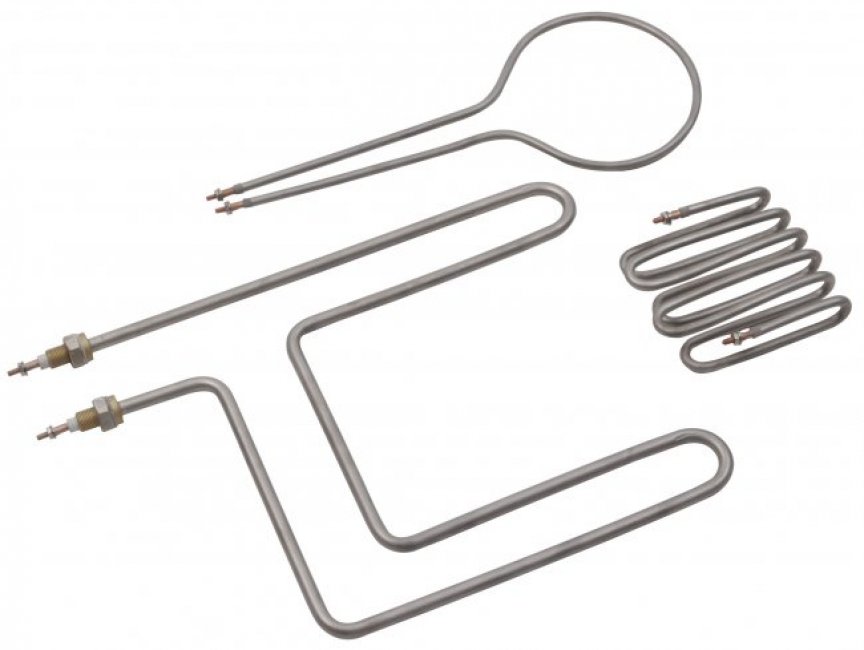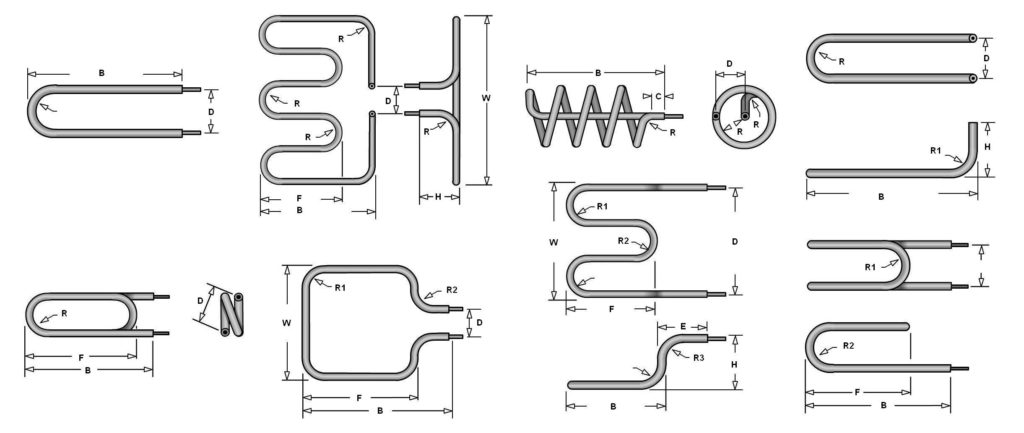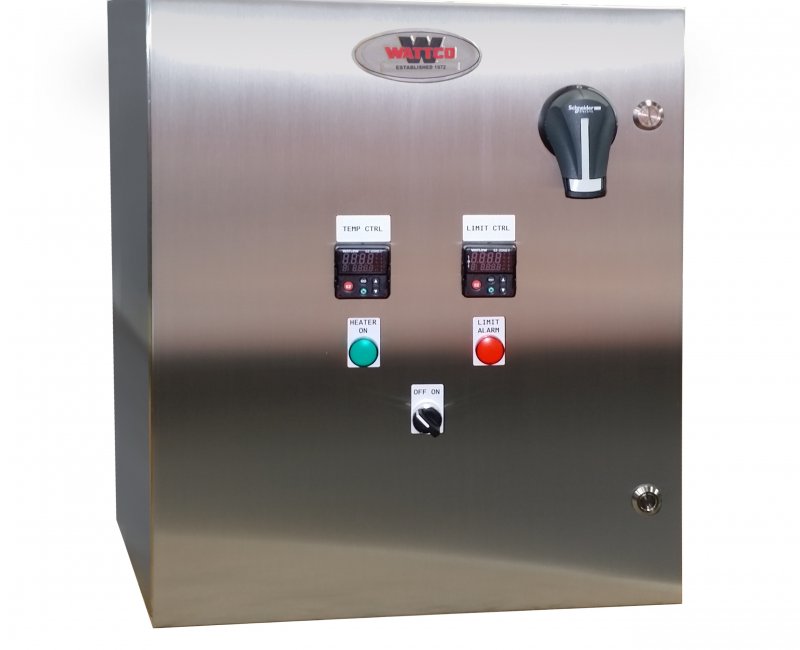Search Results
Tanks requiring industrial tank heaters can utilize indirect heating with band heaters or, they can use direct heating that typically uses some form of immersion heating. Indirect Heating WATTCO Band heaters can be found in several types of dimension, wattage, voltages and material. Mica band heaters are an inexpensive industrial heating solution that surrounds pipes and tubes that require external indirect heating. Pipe heating, drum heating, barrel heating normally used for oils, lubricants or any other circular applications.
Band heaters use electric heating elements (NiCr wire) to heat-up the external surface of drums or pipes for a gradual heat transfer. Band heating is an indirect form of industrial heating and offers safety when heating volatile and explosive substances as well as pipes or containers that cannot otherwise be heated using direct heating methods.
Industrial band heaters can be made with NEMA 1 terminal boxes or NEMA 4 moisture resistant terminal boxes that protect terminations and have the option of a thermostat or thermocouple digital temperature controllers to help control and regulate an applied heat. Insulation is also required to help direct the heat to your application rather than experience heat loss, and slow heat-up time. Band heaters from WATTCO are the ideal solution for high watt densities and high operating temperature applications, especially for the plastics industry.
The various types of band heaters available at WATTCO include mica insulated band heaters and ceramic band heaters. Direct Heating For direct heating, our immersion heaters section is suggested as a more efficient means for heating your liquids. Direct heating uses flanged heaters, screw plug heaters, over the side heaters as well as pipe heaters Get a quote on a band heater today. WATTCO also manufactures other industrial heating products such as infrared heaters, control panels, circulation heaters and more. Click here to view all of our products
Cartridge heaters can be considered “component heaters” that are used to generate heat in many different applications. These process heaters are primarily used in mold and fit snug inside a cavity and helps heat solids by reaching high temperatures. Cartridge heaters have the versatility of being able to carry thermocouple inside to help control temperatures of the heater more accurately. Various diameters allow for it to be used in any cavity and can be custom designed with any cold section. Lead wires extend from the end to your control panels. Cartridge heaters are used as a water heater element and in a wide variety of applications. Some of these uses include bag sealing applications, hydraulic oil applications, motor oil applications, gearboxes, water heating applications as well as laboratory and food equipment. Sheaths can reach extreme temperatures as cartridge heaters can be designed with higher watt densities. High watt density cartridge heaters can also have different types of lead wire connections. For more mechanical processes, stainless steel braided leads are used against mechanical stress. BX cabling can be used for added protection, though it reduces the lead wire flexibility. Terminal pins are also available on all models. Cartridge heaters from Wattco are made of a swaged construction that consists in a high-grade nickel chromium resistance wire wound around a high-quality MgO core that is centered in a stainless steel casing. Cartridge heaters are used for heating metal parts and can also be fitted with threaded bushings for liquid heating for certain applications. Cartridge heaters will reach metal temperatures of up to 1,400ºF (760ºC) with the appropriate material, watt density, and fit selections (see Figure 2 on our catalog page 7.2). Get a quote on a cartridge heater today. WATTCO also manufactures other industrial heating products such as infrared heaters, immersion heaters, pipe heaters and more. Click here to view all of our products.
WATTCO™ duct heaters come in various sizes and dimensions to fit any compartment. Three types of duct heaters are available: open coil, tubular or finned tubular heating elements that are either flanged or inserted in the duct.
Air duct heaters primarily use in air-flowing ventilation systems and comfort-heating applications. Process duct heaters mainly serve industrial process heating applications (ovens that require re-circulated air or forced circulation).
Wattco™ duct heater features
WATTCO™ designs and configures your electric heating element according to your specifications. Our team is dedicated to research and development, using the latest technologies while striving to meet every customer’s needs by manufacturing high-quality industrial heating products.
Since 1969, WATTCO™ has earned a reputation for expertise in developing and manufacturing electrical heating elements that make Wattco duct heaters the most easily adaptable industrial heating solution for most non-pressurized, air-heating systems
Wattco duct heater Usage:
Duct heaters are electric heating devices installed within air ducts to provide localized heating in HVAC systems. Its applications include:
1. Commercial Spaces
Duct heaters are mostly used in commercial buildings to maintain indoor temperatures, particularly in large open areas where standard heating is insufficient.
Example: In a shopping mall, duct heaters are installed in the HVAC system to produce warm heat to areas such as food courts or atriums, regardless of outdoor temperatures. It provides a pleasant shopping experience and longer visits.
2. Industrial Applications
Many industries require a temperature control to offer smooth equipment’s operation and maintain safety hazards.
Example: In a manufacturing plant like chemical or plastics, duct heaters are necessary to maintain the air temperature within a specific range and to avoid product damage or defects due to cold elements.
3. Ventilation Systems
During colder climates, the duct heaters are effective in preheating the incoming air in ventilation systems.
Example: In an office building, the duct heater can be fixed in the fresh air intake line to heat the incoming air before it enters the occupied spaces. This improves indoor comfort and energy savings by reducing the load on the main heating system.
4. Zone Heating
Duct heaters enable target heating at specific zones of larger spaces and also help for better energy management.
Example: In a warehouse with different usage levels, a duct heater can be installed in an area where the meetings and gatherings are hosted. It makes that area get heated independently and saves energy when the space is not in use.
5. Dehumidification
Duct heaters can control humidity levels by heating the air to reduce the moisture.
Example: In a swimming pool, a duct heater can be used to heat the indoor pool air. The warm air can reduce moisture and offer a comfortable environment by preventing mold growth and condensation on surfaces.
Wattco™ duct heater voltages
A broad range of custom-built electric duct industrial heaters with capacities up to 1000kW is available upon request. WATTCO™ heaters are ideal for applications with the following voltages
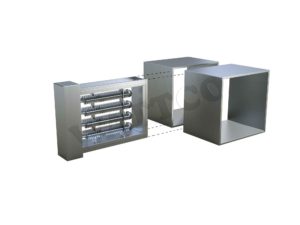
- 347 volts/1 phase
- 600 volts/1 phase
- 600 volts/3 phases
- 208/240 volts/1 phase
- 208 volts/3 phases
WATTCO™ duct heaters have the international, American recognized Canadian Standards Association (CSA us) label, which sets the standards for the electric heating industry. Duct heaters can include proper built-in safety devices to extend the heater’s service life. Get a quote on a duct heater today.
WATTCO also manufactures other industrial heating products such as infrared heaters, control panels, immersion heaters, and more. Click here to view all of our products.
- Medical
- Automotive
- Mining/Oil/Gas
- Construction/Manufacturing
- Thermoforming
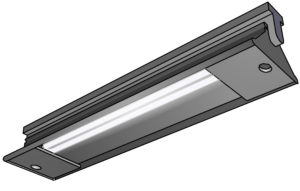 Medical
Medical
Automotive
Infrared radiant heaters have influenced auto manufacturers to realize their benefits in the automotive panel manufacturing projects. Since the workable manufacturing areas was recessed and tight to work within, industrial heating solution manufacturers tried to simplify the problems in using adhesive materials. They designed a form of infrared radiant heating that is capable of drying and annealing two parts together in a shorter time period.
Mining/Oil/Gas
The mining, oil and gas industries have found the best ways to increase their productivity and allowed companies to enhance the quality of products they are manufacturing. They can now combine infrared and microwave heat to clean the oil laced sand from the crude oil tanks.
Construction/Manufacturing
Infrared radiant heaters can be used for creating construction materials that require demanding environments involving extreme temperatures and processing plants. They are helpful in binding different materials together so that something new and worth using can be created, which can satisfy both domestic and industrial needs.
Packaging
Infrared electrical heating elements are used to improve thermoforming efficiency to help companies accomplish numerous objectives. Manufacturers normally create complete systems having maximum control according to the market demands. They have incorporated different mechanisms that are capable of implementing infrared furnace and thermoforming techniques in several packaging tasks. The companies can save up to 40 percent of energy with these heaters and can achieve payback for retrofitting in six months.
Thermoforming
The plastic thermoforming industry is another place where, infrared radiant heaters are frequently used due to their ability of maximizing quality and efficiency of the companies. The heaters are known to reduce average expenses on thermoforming, thus affecting the profit margin of users up to 40 percent. They can also enhance the effectiveness of fixed capital assets as compared to spending millions on their replacement.
Finned strip heaters, often considered component heaters, are an electric heating element that maximizes heat intensity and transfer effectively in an area. Steel fin strip heaters are an excellent industrial heating product that can be easily controlled by using a heating control panel, mechanical thermostat or cost effective bi-metal thermostats that can be installed on the surface of the heater. Mounting holes are useful to mount the heaters securely on the wall housing with terminal extending from the sheath for easy electrical connections. Many users also request lead wires that extend from one end that make the installation more flexible as the temperature controller is easily adaptable to this configuration. Temperatures can reach as high as 500 degrees F and use the high quality magnesium oxide that is also used in tubular heating elements that allow for effective heat transfer. Finned strip heaters are a fairly inexpensive way of heating small areas and are an excellent solution to meet any budget. Finned strip heaters are composed of a heating element, a protective sleeve or sheath, and mounting hardware along with steel finned that are used to extend surface area. If strip heaters are used as a radiant heater, or a duct heater, they have can have fins to maximize surface area and heat transfer to the air. Strip heaters can be clamped or bolted onto objects or solid surface contact heating over large areas and are primarily used in indoor applications. Get a quote on a finned strip heater today. WATTCO also manufactures other industrial heating products such as infrared heaters, immersion heaters, pipe heaters and more. Click here to view all of our products
Finned tubular heating elements from WATTCO™ are the most versatile and dependable electric heating element available today. These industrial heating solutions are among the most common heaters and are best suited for a large number of applications such as conduction, convection, and radiation. WATTCO™ factory-configures every tubular process heater to almost any shape or size. Custom bending diameters can be made upon request. WATTCO uses the finest materials in construction such as steel, stainless steel, incoloy, inconel and/or titanium alloys. WATTCO also uses high quality magnesium oxide to allow for efficient heat transfer from resistive coil to your heating medium whether it is air, liquid or solid. These heater elements have a strong outer sheath to help protect the heater from physical stress and uses high quality alloys to allow efficient heat transfer from resistance coil to your heating medium. Depending on their rating, sheath and shape, WATTCO™ electric tubular elements are used in a variety of heat applications that require process temperatures of up to 750°C (1 382°F) to heat liquids, gases and solids. A variety of diameters are available to help adjust watt densities in your application to design these electric heaters for best performance and long life. Standard and custom made terminal pins allow for easy installation and maintenance. Bending radiuses are designed with careful expertise to allow for optimal performance when meeting “form fit and function” within your application.
Get a quote on a tubular heater today. WATTCO also manufactures other industrial heating products such as infrared heaters, immersion heaters, circulation heaters and more. Click here to view all of our products. 
Industrial immersion heaters are a fast and efficient way of heating up various liquid solutions in processing equipment, as well as in large tanks through the use of tank immersion heaters. Heating up liquids using direct heat transfer allows for the liquid medium to quickly reach the desired temperature using electric heating elements such as flanged heaters, screw plug heaters, over the side heaters or immersion water heaters.
This application is commonly used in chemical processes, large petrochemical containers as well as large water containers that require fast heat up time. With minimal maintenance requirements, immersion heaters are an excellent solution to rapid heating in almost any industrial environment.
The use of electric immersion heaters has been more popular in the past several decades as rising costs of fuels (and the necessary infrastructure that comes with it) force individuals to select a more cost efficient way of heating their applications. Ecologically conscientious groups have long advocated for cleaner energies to help save the environment. Electric immersion heaters have been known to use the cleanest form of energy, leaving no residual discharge and provide immediate heat transfer to any medium.
Types of Immersion Heaters
WATTCO manufactures a variety of immersion heaters including flanged immersion heaters, circulation heaters, inline heaters, and over-the-side heaters.
https://www.youtube.com/watch?v=je61phStrLE
Flanged Immersion Heaters
Flanged immersion heaters have the ability to hold multiple hairpin elements that can be mounted onto the side of a container (commonly referred to as a tank immersion heater). Its versatility allows it to offer up to 750 KW of power on a single unit. Among its various uses include utility companies, defence contractors, petrochemical researchers and boiler manufacturers.
Learn more about our Flanged Immersion Heaters 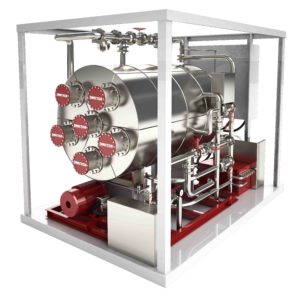
Circulation Heaters (or In Line Heaters)
Circulation heaters (or In Line Heaters) use flanged immersion heaters or screw plug heaters within a vessel chamber to heat up liquids from an inlet and expels the heated liquid through an outlet using the force of a pump to allow easy circulation. The circuit of running liquid is then reheated to reach a target temperature. It is often referred to as the most efficient use of electric heating as heat is initially applied to liquid at ambient temperature, but then recirculated at an elevated temperature that does not require as much energy to reach your target temperature.
The use of insulation around piping and the tank itself allows the heat to be contained. The circulation vessel is often reinforced with high quality insulation that helps prevent heat loss. Coupled with the use of a high quality alloy that prevents heat loss (high grade stainless steel) the unit is a complete system that allows users to use thermocouples, RTD temperature sensors or standard mechanical thermostats to maintain liquids at optimum temperatures.
Safety sensors are also available such as high temperature sensors to help prevent excessive heat or over temperatures. This protects both the liquid you are heating as well as protection to your industrial heater.
Learn more about our circulation heaters
Learn more about our in-line heaters
Over-The-Side Heaters
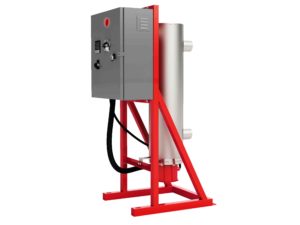
Over-the-side heaters are used to heat up larger containers of liquid that have openings. Immersion heaters and tank immersion heaters are often available with several different ranges of temperatures that can be fine tuned for extreme accuracy. As such, very tight and efficient control can be maintained which has a positive effect on the performance of the industrial plant. Along with this, several mounting options can be also be availed which further facilitate processes. Examples include screw plug connections, over the side designs, 3 phase immersion heaters, immersion water heaters and flanges. There are several options for piping as well such as flanged, welded or threaded.
Get a Quote on an Immersion Heater Today
WATTCO also manufactures other industrial heating solutions such as infrared heaters, screw plug heaters, pipe heaters and more. Click here to view all of our products.
Solid State Power Switching devices are underappreciated in the arena of temperature control panels. Yet, the fact that they are overlooked cannot create doubts about their usefulness and need in the operations.
Advantages of Hybrid Temperature Control Panels
Solid-state switching devices are semiconductors that control the power, either voltage or current, supplied to the production system. While their job is primarily to switch the power on and off at a rapid pace according to the controller’s instructions, they can do multiple standalone functions that primarily include diagnostic and supervisory functions.
They can be seen in a similar light to electronic circuit breakers because of their ability to protect the system from damage caused by unchecked temperature settings or power supplies. Their reliability and ability to easily manage fast-paced switching operations increase their functionality and demand in the market.
They are best utilized in low-noise areas and in areas that are switched frequently, for example to control resistive loads, conveyor systems, etc. Their compact design makes them a viable choice for use in control cabinets, allowing for greater space availability.
There are a number of outputs that are used with temperature and process controllers, some of the common ones include, solid state relay drivers, linear along outputs, relay outputs, and triac. The relay output commonly is a single pot double throw relay which comes with a DC voltage coil.
The controller works by isolating the contacts using the energy added to the relay coil. This lets the contacts make use of the external voltage source, which ultimately powers the larger heating contactor. The contacts used in the process are designed to control the output in addition to handling the process timing and proper execution.
Temperature and process controllers are an integral part of the workings of a number of industries. The best industrial functions need proper maintenance of process schedules and temperature levels both of which are controlled by these controllers.
Food and Beverage Industry Packaging
The packaging industry is heavily dependent on temperature maintenance for proper functioning. The machinery used in packaging which includes hot melt functions, glue applicators, seal bars, label applicators, and shrink wrap tunnels are designed to operate at a certain temperature and to process for a set length of time. Both of these processes are regulated by temperature and process controls. Process controllers control the process time limit, while temperature controllers ensure that the wanted temperature is maintained throughout.
Food and beverage industry
The food and beverage industry is another place where temperature plays a vital role. The use of temperature and process controllers in the industry is for a variety of purposes such as blending, sterilization, brewing, cooking, baking ovens etc. Temperature and process controllers make sure that the temperature is regulated and optimum performance ensured.
Temperature Control Panels for the Plastic Industry
The plastic industry makes a slightly different use of temperature controllers than boilers or kilns. They look to use them in relation to controlling portable chillers, dryers, hopers, extruding equipment and molding. As far as the extruding equipment is concerned, the use of process controllers in combination with temperature controllers is to precisely monitor and control temperature at the different critical points in its operation.
Temperature Control Panels for Heat Treating Applications
One of the most common uses of temperature and process controllers are in heating ovens or in heat treating applications such as boilers, exchangers, ceramic kilns and different types of furnaces.
WATTCO Multistage Temperature Control Panels come with the On-Off panels with the following options:
24V transformer
Step Controller
Contactors and Fuses for multiple load variations
Option to have an SCR Contactor
Get a quote on a multistage temperature control panel today. WATTCO also manufactures other industrial heating products such as infrared heaters, circulation heaters and more. Click here to view all of our products.
Open coil elements are the most efficient type of electric heating element and the most economically feasible for most heating applications. Used predominantly in the duct heating industry, open coil heater elements have open circuits that heat air directly from the suspended resistive coils. These industrial heating elements have fast heat up times that improve efficiency and have been designed for low maintenance and easily, inexpensive replacement parts.
Wattco open coil elements
Open coil heating elements from Wattco are typically made for duct process heating, forced air & ovens and for pipe heating applications. Open coil heater elements are made to fit inside standard 2’’ or 3’’ schedule 40 NPS pipe. Open coil heaters are used in tank, pipe heating, and/or metal tubing. A minimum clearance of 1/8’’ is required between the ceramic and the inside wall of the tube. An open coil element will provide excellent and uniform heat distribution over a large surface area.
Open coil heater elements are an indirect industrial heating solution to decrease watt density requirements or the heat fluxes on the surface area of the pipe connected to the heated section and prevent heat-sensitive materials from coking or breaking down.
Get a quote for an open coil element today. WATTCO also manufactures other industrial heating products such as infrared heaters, control panels, circulation heaters and more. Click here to view all of our products.
Over the side (OTS) heaters are a popular industrial heating product due to their cost-efficiency and practicality. Using a water-resistant terminal housing, these industrial heaters come in many shapes and sizes to fit your tank’s dimensions and specifications.
Mobility
Wattco’s over the side immersion heaters are custom designed with multiple tubular elements and a thermowell to hold your temperature probe. Shaped to fit within your standard (or non-standard tank), the economic feasibility can meet the budget of any project manager. The mobility of these heaters allows for usage in multiple containers and can be a superior choice for many project managers.
Wattco™ over the side heater (OTS) features
Wattco™ uses high-quality stainless steel and other exotic alloys to meet the requirements of any application. With a digital control panel, this heater becomes the perfect solution for heating large containers with no access to the liquid except from the top. Brackets are used to support the heater onto the wall of the tank, and cold sections are carefully calculated to prevent overheating when water or liquid levels drop below certain levels as a result of evaporation or drainage.
Over the side (OTS) heater industrial uses
Using high-quality alloys, Wattco™’s over the side heaters are strong enough to physically withstand many harsh environments both indoors and outdoors. Commonly used in petroleum and chemical industries, it is an exceptional choice for projects with limited budgets.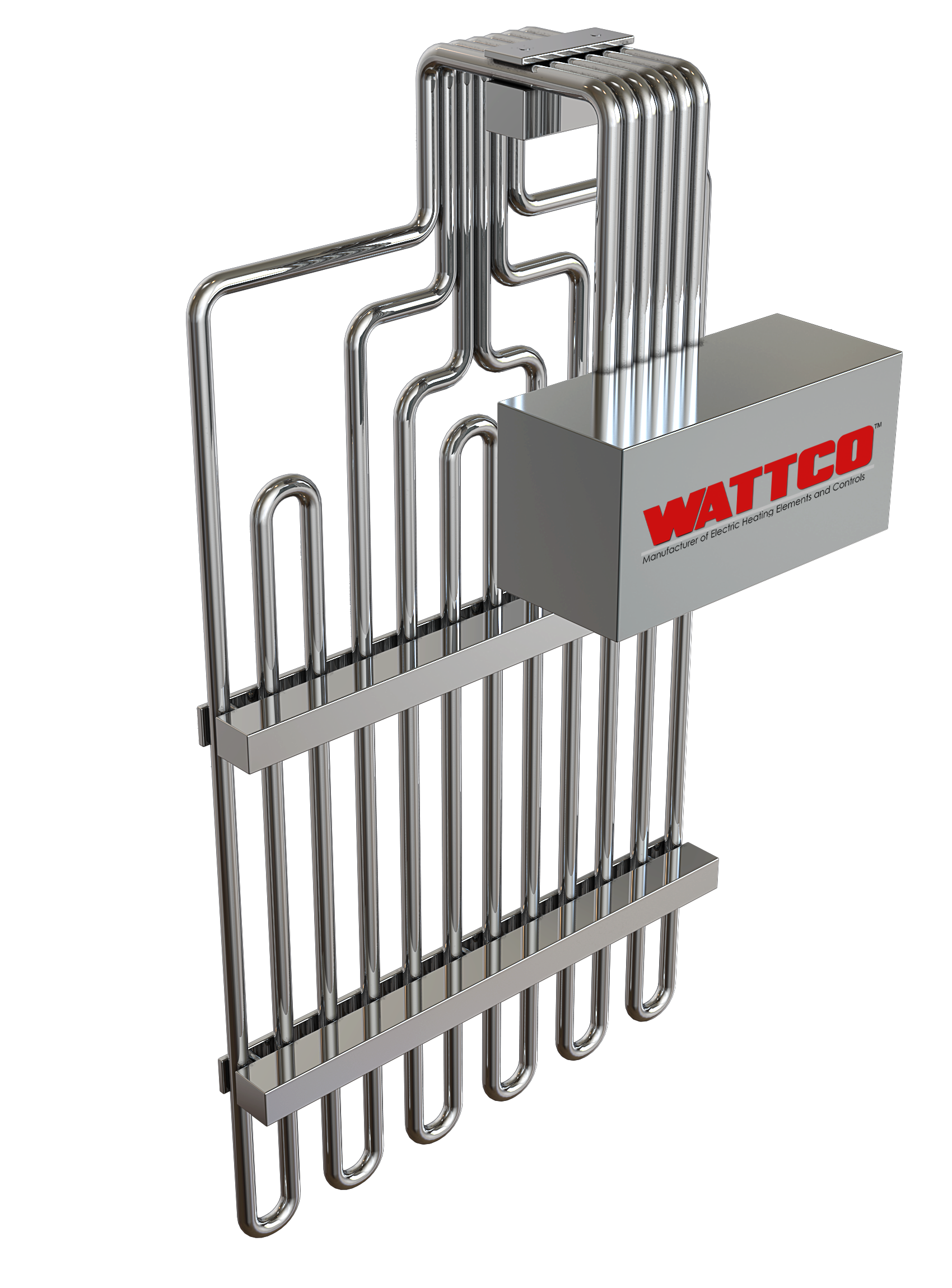
Wattco’s over the side (OTS) heaters advantages
Over the side immersion heaters are specifically designed to be installed in the upper portion of tanks. The substance to be heated is either below the industrial tank heater or onto one side, hence the name. The main advantages of this approach are that ample space is left in the tank for other operations to take place, and the heater can easily be removed when the required temperature is achieved within the substance.
The heating element of an over the side process heater is usually made from steel, copper, cast alloy and titanium. A coating of fluoropolymer or quartz can be provided for protection.
There are several applications in which over the side heaters can be used, such as heating oils of varying viscosities, degreasing solutions, heat transfer oils and caustic solutions.
Get a quote on an over the side heater today. Wattco™ also manufactures other popular industrial heating solutions such as infrared heaters, pipe heaters and circulation heaters. Click here to view all of our products.
Silicone rubber heaters from WATTCO™ are composed of fiberglass reinforced silicone rubbers that are moisture and chemical resistant. Thin and flexible, silicone rubber heater elements are designed to meet the requirements of various low and medium temperature applications that require irregular shapes, sizes, and dimensions. Silicone heaters are known for their unique and flexible properties and can withstand mechanical shock and vibration. Silicone heaters have unique qualities such as a high dielectric strength, non-toxicity, and flame retardance. Silicone heaters consist of two “wafers” of silicone with a heating resistor sandwiched in between.
Thermostat controls are options that are used to help reach your target temperature. Teflon lead wires exit any location of your choosing and are offered at any length you require. Perfect for applications that require direct heat such as surfaces, barrels, conical shapes as well as in cylinders and small areas where traditional electric heating elements cannot fit. Adhesive backing is also available to help with fixation. Silicone heaters are used in applications requiring temperatures upwards of 450 degrees F such as freeze protection of electrical enclosures. Get a quote on a silicone rubber heater today.
How Silicone Rubber Heaters Work
Silicone rubber heaters operate on the basic principle of resistive heating, where electrical energy is converted into heat as it passes through the resistive heating element.
Power Supply:
These heaters operates on AC power, with voltages ranging from 12V to 480V depending on the application and industrial usage.
Heat Generation:
When an electric current flows through the resistive wire, the electrical resistance causes the material to heat up. The heat is then transferred evenly across the silicone rubber surface.
Uniform Heat Distribution:
Due to the flexibility of silicone rubber heaters and the embedded heating elements, the heat is distributed uniformly across the surface.
This ensures consistent heating, which is critical in process heating and temperature-sensitive applications.
Thermostats and Temperature Control:
Many silicone rubber heaters can be equipped with built-in thermostats, heating elements or sensors to regulate the temperature. External temperature controllers can also be used for more precise control.
WATTCO also manufactures other industrial heating products such as infrared heaters, control panels, circulation heaters and more. Click here to view all of our products
Strip heaters, or component heaters, provide an easy and efficient way of using surface area for effective heat transfer.
Steel strip heaters are an excellent industrial heating product. Using a temperature controller such as a mechanical thermostat makes them easy to control. Installing a bimetal thermostat on the heated surface is another cost-effective solution for strip heating.
Installing strip heaters
Mounting holes help mount process heaters securely on almost any surface, with the terminal extending from the sheath for easy electrical connections. Many users also request lead wires that extend from one end that make the installation more flexible as the temperature control panel is easily adaptable to this configuration.
Strip heater features
Temperatures reach as high as 500℉ (260℃) and use the high-quality magnesium oxide found in tubular elements that allow effective heat transfer. An inexpensive way of heating surfaces or small areas, strip heaters are an excellent solution to meet any budget.
Strip heaters are composed of a heating element, a protective sleeve or sheath, and mounting hardware. Radiant heater strip heaters can have fins to maximize surface area and heat transfer to the air. Strip heaters can be clamped or bolted onto objects or solid surface contact heating over large areas. That makes them optimal for indoor applications where strip heating can be applied.
Get a quote on a strip heater today. Wattco™ also manufactures other industrial heating products such as infrared heaters, immersion heaters, pipe heaters, and more. Click here to view all of our products.
Control panels are used to maintain the heating system’s stability and heat transfer efficiency to prevent issues such as overheating and chemical disintegrations of a fluid. To provide the precise safety mechanism of the heating system, control panels can also be entirely customized to meet most of the requirements of the target application.
Terminal boxes in Wattco™ temperature control panels
Various terminal boxes are available depending on the protection required- moisture-proof, explosion-proof, waterproof, and dustproof. A NEMA 1 standard terminal box is normally suitable for non-hazardous area operations.
NEMA 4 terminal boxes (weather-resistant enclosures) are commonly used for outdoor operation, which requires protection against moisture and humidity. Digital temperature controllers are installed to monitor the ambient and set-point temperature. A typical control panel set possesses of switching and fusing devices, including internal wirings.
Safety sensors for temperature control panels
Along with the temperature sensor tools such as RTD and thermocouples, Wattco’s control panels will ensure maximum heat generation safety for various voltage ranges. The support and safety documentation (with schematics support, drawings, and bills of material) would ensure the control panels will be installed and operated perfectly as designed. Industrial control panels regulate temperature and provide safety mechanisms to prevent overheating your liquid and protect your heating elements.
Temperature control panels for hazardous operations
Control panels come in many different terminal boxes – standard NEMA 1 terminal boxes, dust proof boxes, waterproof boxes and explosion-proof boxes for hazardous areas. Digital controllers are used to display ambient and target temperatures of your solution. They contain contactors, relays, fuses, on–off disconnect switches, and other components to help regulate your Wattco™ heater in a safe environment. In conjunction with thermocouples or RTD sensors, temperature controllers are the “brains” of the system and determine the heat intensity of your heaters.
Voltages for temperature control panels
Heating control panels are typically available for heaters generating at least 30 Amps to over 200 Amperes. Special accommodations can be made for systems that are over 200 Amperes. NEMA 4 terminal boxes are typically used for outdoor applications where concerns of moisture and humidity is a factor. Flow switches can also be used for circulation heaters. All Wattco™ control panels come with circuit schematics and support documentation that might be required for configuration purposes.
Get a quote on a control panel today. Wattco™ also manufactures other industrial heating products such as circulation heaters, infrared heaters, immersion heaters and more. Click here to view all of our products.

Blog Search Results
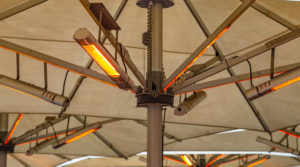 Delve into the realm of infrared heaters and their unparalleled energy efficiency benefits. Discover how these advanced heating solutions can revolutionize your energy consumption and lower your carbon footprint. From their targeted heat delivery to quick response times, explore the science behind infrared heaters and learn how to optimize their energy efficiency for a greener and more cost-effective heating solution.
Delve into the realm of infrared heaters and their unparalleled energy efficiency benefits. Discover how these advanced heating solutions can revolutionize your energy consumption and lower your carbon footprint. From their targeted heat delivery to quick response times, explore the science behind infrared heaters and learn how to optimize their energy efficiency for a greener and more cost-effective heating solution.
The science behind infrared heaters
Infrared heaters are made with a heating system and a reflector. The heating system converts electric or chemical energy into thermal energy as the reflector directs the generated heat toward the intended room, object, or material.
The key to the energy efficiency of infrared heaters is the type of material used as the reflector. It should have a high reflectivity rate and a low absorption rate. The less heat it absorbs, the more heat can be sent to the right place. Good reflective materials are aluminum, stainless steel, ceramics, and quartz.
Sometimes, the reflectors will be covered in other metals like gold, or ruby, to improve their reflective properties. Reflectors will be shaped in certain ways to ensure the infrared waves of heat flow efficiently outwards without bouncing back.
The heat generated by infrared heaters is unique in that it doesn’t heat the surrounding air. The electromagnetic waves flow unobstructed until they hit their target, and that will be where the heat starts to build.
This means infrared heaters are energy efficient since they don’t waste heat along the way. They’re convenient and normally safe to use since they can be used casually in places like the garage, a living room, a cottage, or a shed. On the industrial side, they’re used for drying, printing, curing, and more purposes.
Leveraging the energy efficiency of infrared heaters
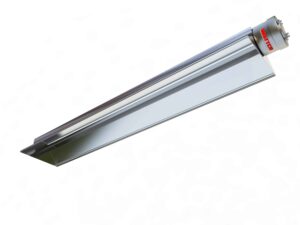 Consider the parameters of your project, whether large or small and see how many of these points line up with your needs:
Consider the parameters of your project, whether large or small and see how many of these points line up with your needs:
- Infrared heaters have minimal heat loss since the ambient air isn’t heated, only the intended target. For example, if a surface or material needs to be dried with heat, an infrared heater can focus on the target as opposed to warming the entire room.
- Where quick heating is necessary, infrared heaters reach their target temperature quickly and send it directly to the target. You won’t have to wait for the whole room to reach the right temperature to know the medium is being heated.
- Infrared heating isn’t harsh; it’s a more natural heat like that which you’d feel from the sun. However, while providing heat, it won’t affect humidity levels, reduce oxygen levels, or evaporate moisture in the air.
- Where moisture is a concern, infrared heaters will help reduce mold and mildew. These growths are inhibited since the moisture’s mobility is limited. This is beneficial in industries working with medicine or food where moisture can ruin the supply.
- If the area is already loud enough, or the area is quiet and must stay that way, infrared heaters are an excellent choice since they don’t produce noise. They don’t use fans, engines, or other noisy components.
- In health-care scenarios, for example, since infrared heaters are electric and don’t use particulates that affect the air, breathing clean air isn’t a concern, and neither is the agitation of particulates, toxins, or allergens in the air.
- On the physical side, infrared heaters don’t dry out the skin and produce new problems. Rather, they help with blood circulation, respiration, pain and inflammation, and quality sleep.
Many of these points are reasons why industries, such as pharmaceuticals, food and beverage, and health care, opt for infrared heaters when needed. There’s such an efficient heat delivery without negative side effects that fragile or health-related processes can operate without concern.
This isn’t to say that industrial settings can’t benefit as well. With direct heating, quiet running, and safe operation, industrial settings can use the heat they need without adding to the ambient temperature.
Wattco’s low carbon footprint products
Much like infrared heaters, Wattco’s other products are already environmentally friendly and energy efficient, with upgrades always underway to continuously provide the best, sustainable products to our customers. Whether you’re looking for infrared heaters, duct heaters, or silicone rubber heaters, check out our products, and contact us with any questions.
There are many different uses and applications for electric heating elements in various processing and industrial manufacturing industries. One of the most common heating elements within this field is electric infrared heaters (interchangeably called “IR” or radiant heaters). Electric heating elements such as these aid manufacturing and industrial processes primarily by maintaining substances (such as adhesives or oil residue) at the correct temperature needed for efficient processing. 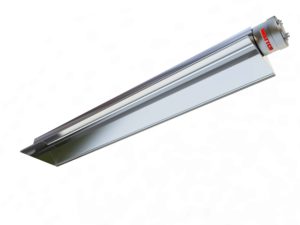 Infrared heaters are ideal for a variety of reasons.
Infrared heaters are ideal for a variety of reasons.
First, the radiant method of heating is energy efficient. This means the electric heating elements have a great spot in the modern, green world.
Second, electric infrared heaters are most helpful in heavy-duty projects that require high temperatures and high intensity.
Third, the specifications and method of heating for electric infrared heaters make the heating elements easy to clean and maintain. As well, they are cost-effective in comparison to other available options.
Finally, infrared heaters are ideal for the industrial sector because they can be applied across many industries, from the medical and automotive industries to the mining, oil and gas industries.
Infrared Heaters
Infrared radiant heaters are also commonly used in industrial settings as space heaters for large areas, such as ice rinks, aircraft hangars, and parking garages. There are two primary forms of electric heating elements: direct heaters and indirect heaters.
Direct immersion heaters, as the name implies, immerse the main heating element directly into the liquid, while indirect heaters conduct heat through radiation or convection. As a result, infrared heaters are considered indirect immersion heaters since the heating element transfers heat to and maintain the temperature of the given liquid. The heater uses radiation, rather than direct contact. In this way, electric infrared heaters are energy efficient, as they transfer entirely electric power into heating the liquid or substance, with very letter energy lost along the way.
Industrial Infrared Heaters
 Infrared heaters in an industrial setting are heavy-duty units designed to emit high-intensity heat. This is achieved by using tubular elements that can be easily replaced if the needed arises. The tubes of the heating element frequently use quartz elements. This allows them to bear the high temperatures associated with their use. The rest of the heater is usually stainless steel to ensure long-lasting usage.
Infrared heaters in an industrial setting are heavy-duty units designed to emit high-intensity heat. This is achieved by using tubular elements that can be easily replaced if the needed arises. The tubes of the heating element frequently use quartz elements. This allows them to bear the high temperatures associated with their use. The rest of the heater is usually stainless steel to ensure long-lasting usage.
The tubes can also be equipped with waterproof casing to protect the heating element from moisture penetration such as humidity. Electric infrared heaters are usually paired with digital or mechanical controls, making the application of the heating element virtually limitless. Infrared heaters have begun to be used in the medical field. This is as professionals have realized that the heating elements are effective in separating blood platelets. The heating elements are used in the automotive industry in drying adhesive materials more efficiently, and in the mining, oil and gas industry to clean crude oil tanks. Ultimately, electric infrared heaters are most useful in heavy-duty, high-temperature products. This is because of their efficiency, ease of use and maintenance, and versatility of applications.
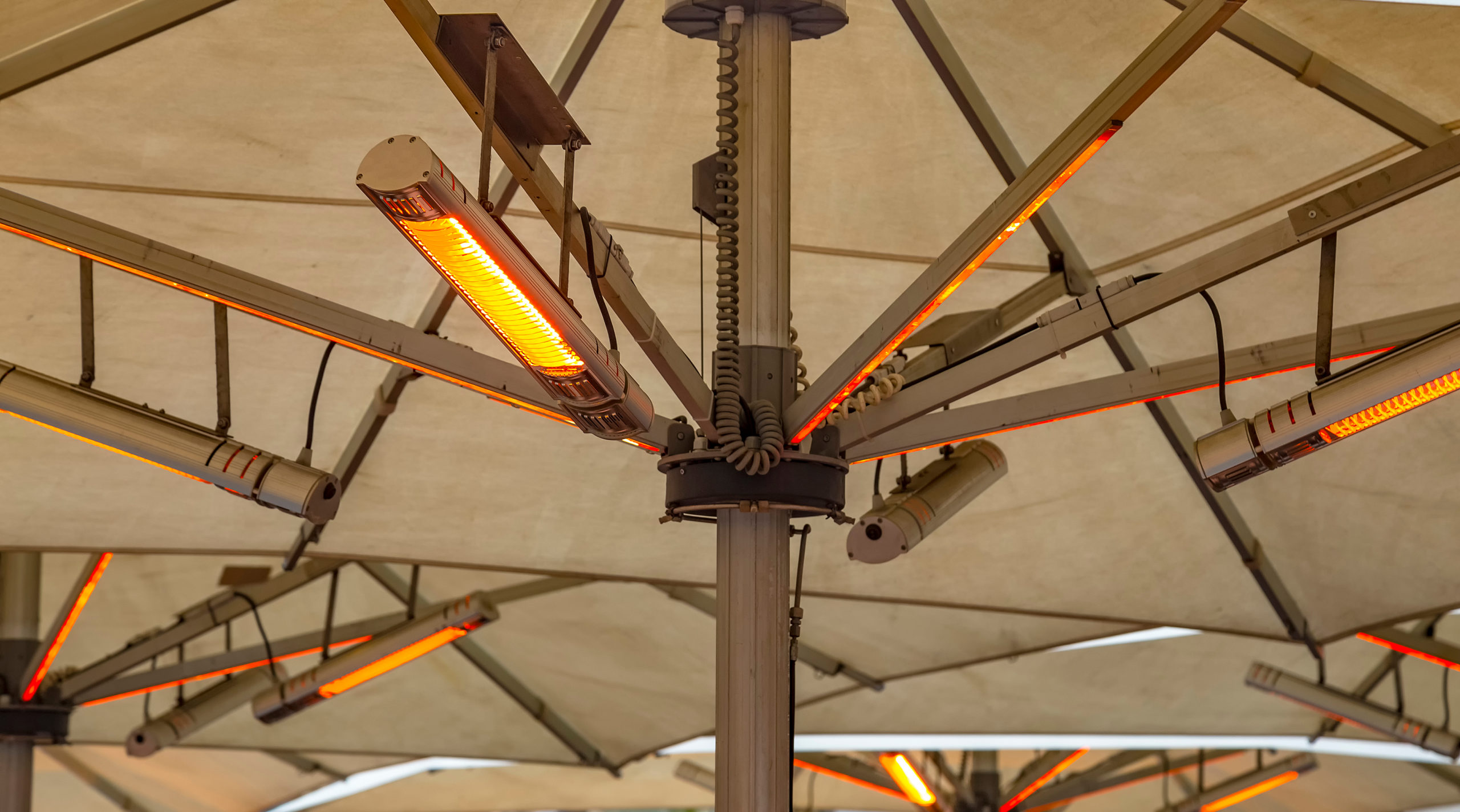 An Introduction to Infrared Heaters
An Introduction to Infrared Heaters
Infrared heaters are commonly used in large indoor and outdoor areas that transfer heat energy through electromagnetic radiation. Shopping malls, gymnasium, storage chambers are a few examples where these devices are installed to keep the internal temperature stabilized. The other applications include food stalls and restaurants to keep edible items hot, especially meat made products.
What Is Radiant Heating
The process to transfer heat energy via infrared heater is known as radiant heating. The heat is similar in nature to that of sunlight, which is why it is also known as a synthetic means to provide warmth.
Technicalities
Different type of these heaters basically vary depending on the wavelength of infrared radiation that ranges from 780 nm to 1 mm. Check out below for classifications.
- Such infrared heating devices that emit heat having visible light are known as shortwave heaters. Their wavelength lies between 780 to 1,400 nm which can easily be observed with a naked eye.
- Medium wavelength ranges between 1,400 to 3,000 nm. Slightly visible from normal eyesight.
- Such heaters having infra-radiation above 3,000 are known as “Far-infrared or dark emitters”. Non-visible to a human eye.
Elements Used
In electrical infrared heating devices, tungsten wire is commonly used as a filament, which is shaped like a coil providing more surface area. Low-quality alternatives for tungsten are carbon, iron alloy, aluminum and chromium. Carbon heats up quite rapidly as compared to other filament materials.
Gold coating over quartz tube is used in infrared heaters during industrial processes, which directly emanate heat towards the targeted product. Gold is considered to have a higher infrared reflective feature and is prone to oxidation.
Applications
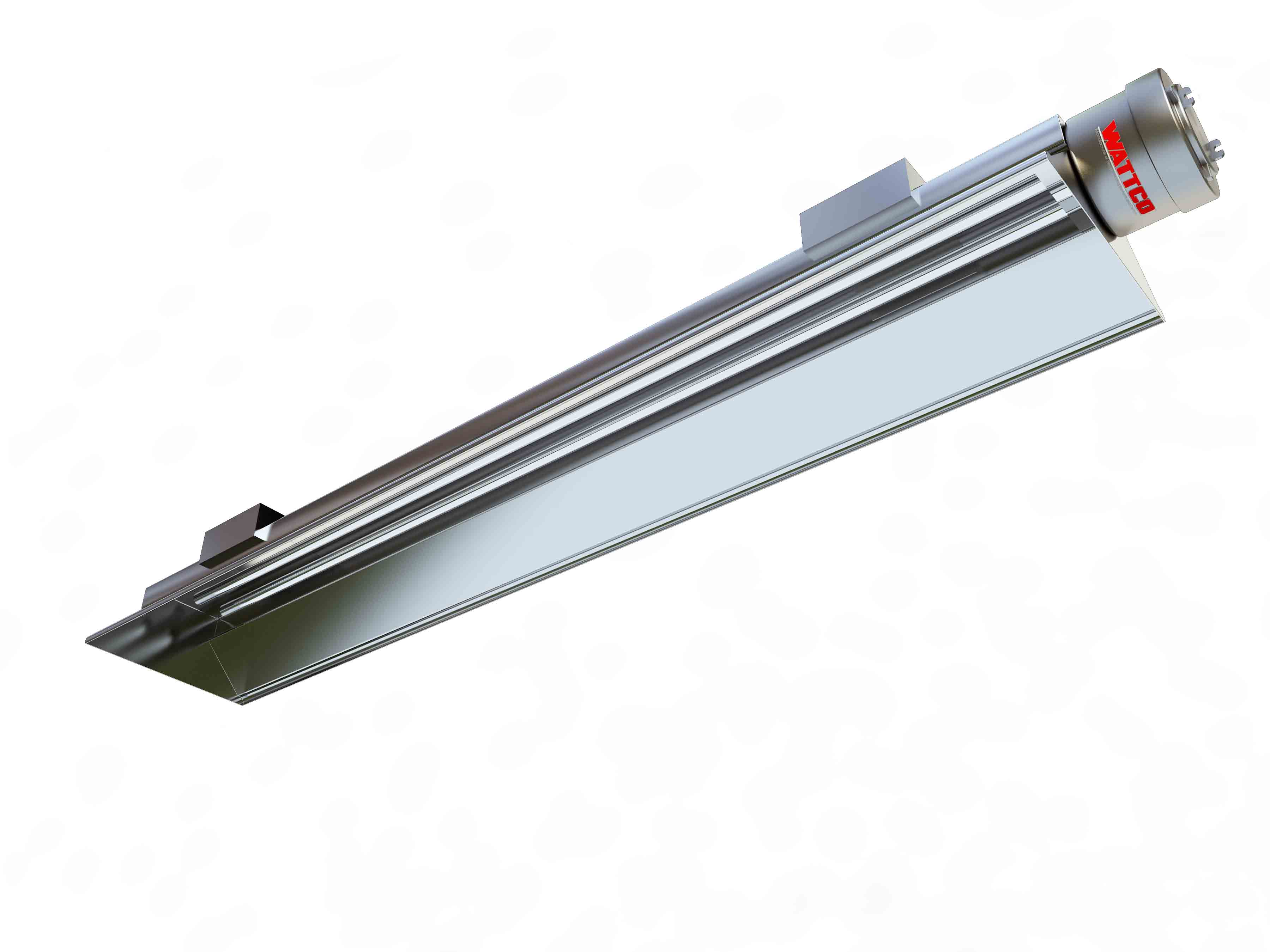 IR heating devices are generally used in the following processes.
IR heating devices are generally used in the following processes.
- For shrinking, welding and heating plastic before giving it a specific shape
- Treating of glass and metal via high temperature
- In cooking
- In zoos, garages and veterinary clinics to provide warmth to tropical reptiles, amphibians and birds
- Curative treatment of coatings
Possible Health Effects
Different tests and experiments were performed over IR heaters and their effects on human skin and health in case of prolonged exposure. Details are given as follows.
- High-intensity shortwave IR radiation causes thermal burn if the device is placed too close.
- Workers and engineers like welders, glass blowers often complain of itching and burning in the eyes.
Common reason for this is the de-pigmentation of iris and weakening of aqueous humor. However, if preventive measures are taken prior getting exposed to the device, you can easily reduce the above-mentioned ailments.
Primary Aspects
Check out below for some of the basic features you will get using infrared heating tools via radiant heating.
- The heat is provided rapidly when device is turned ON. Similarly, it also cools down within moments after powering off.
- Many different sizes, watt densities and filament materials available in market for you to choose from.
All the Benefits You Will Get
Flexible design and outlook for easy handling
- Simple to install, maintain and cleanup without any hassle
- Eco and budget friendly
- Maximum output with minimum heat dissipation
- Easy to carry and attuned to local power outlet
- Long lasting with robust technology
- Anti-corrosive and oxidant
For further details and information, feel free to visit https://www.wattco.com/product_category/infrared-radiant-heaters/
Mining operations require a significant amount of heating and ventilation, especially in colder climates. It’s not uncommon for heating systems to add up to 50% of ventilating costs and almost 40% of total energy costs.
The challenge for mining companies is to find industrial units that are cost-efficient yet effective. That’s where infrared radiant heaters come in. These industrial units carry numerous benefits that reduce the burdens of mining jobs.
High Energy Efficiency
 The key to keeping energy costs in mining operations low is to use energy-efficient heating systems. Infrared radiant heaters offer a high level of energy efficiency since they use almost 100% of the heat they produce. The heating element in an industrial radiant heater converts electricity into radiant heat, which transfers to the liquid (or air) to maintain a high temperature. The heat they generate is sufficient for mining jobs such as cleaning oil-laced sand from crude oil tanks.
The key to keeping energy costs in mining operations low is to use energy-efficient heating systems. Infrared radiant heaters offer a high level of energy efficiency since they use almost 100% of the heat they produce. The heating element in an industrial radiant heater converts electricity into radiant heat, which transfers to the liquid (or air) to maintain a high temperature. The heat they generate is sufficient for mining jobs such as cleaning oil-laced sand from crude oil tanks.
Minimal Maintenance
Traditional heaters may require significant upkeep because they have several components. If one of these components blows out or malfunctions, you will need to replace them, which takes time, effort and money.
An infrared radiant heater, on the other hand, requires minimal maintenance. These heaters don’t have moving parts such as motors or filters found in other industrial heating units. At most, all that’s needed is the replacement of reflectors to maintain heating efficiency.
Reduced Operating Costs
Heat transfer in mining often requires a robust distribution system. Generally, that means a system can heat low-to-medium temperature water and air from geothermal extraction points. These systems tend to produce significant amounts of energy that get wasted, increasing the project’s overall cost.
Infrared radiant heaters only need to generate low wattages to produce adequate heat and use virtually 100% of their electricity. That means little or no wasting of energy, meaning more energy use per dollar spent. That makes infrared radiant heaters much more cost-efficient than other heaters.
Lower Carbon Footprint
It is no surprise that heaters place considerable demand on the environment – they leave a heavy carbon footprint. Fuel-based heating solutions are still the most common method to generate heat for mining applications. Unfortunately, these heating units contribute to much of the world’s carbon dioxide emissions.
Industrial infrared radiant heaters use pure electricity to generate heat, so they don’t produce harmful emissions. They also generate substantial heat using low wattage, reducing their carbon footprint. That’s why infrared heaters are at the forefront of renewable solutions for heating needs in the future.
Improved Safety Conditions
Many industrial heating units pose safety risks to miners (as well as other occupations). Their heating methods come with a chance of combustion and explosion, the circulation of flammable vapours, toxic gases and more. These conditions are hazardous in enclosed spaces, common in many mining operations.
Infrared radiant heaters produce ample heat without many of these risks. First and foremost, they use pure electricity to generate heat, so they don’t circulate flammable or toxic gases. Also, infrared radiation is safe for human exposure compared to other types such as UV rays.
With that said, infrared heaters can cause burns in the case of prolonged, direct contact. But these risks are rare and avoidable.
Consider Infrared Radiant Heaters for Your Mining Operations
The mining industry is very demanding for various reasons, one of them being heating and energy costs. Technology has improved over the decades, giving rise to more efficient methods of heating and infrared radiant heaters are among them. They are a safe, efficient, low-cost and low-maintenance solution to keep mining operations in motion.
Are you interested in using infrared radiant heaters for your mining needs? Get in touch with us for a quote.
The radiators that this article is about are clean, efficient, and economic. Infrared radiant heaters are heaters used for comfort heating applications, particularly in places that require radiant heat. Infrared heaters are not only limited to indoor heating, but are perfectly capable of functioning outdoors and other areas that are exposed using the direct transfer of infrared heat.  The use of these heaters is primarily done in large swathes of areas such as ice rings, sawmills, auditoriums, arenas, gymnasiums, parks, aircraft hangars, and racetracks etc.
The use of these heaters is primarily done in large swathes of areas such as ice rings, sawmills, auditoriums, arenas, gymnasiums, parks, aircraft hangars, and racetracks etc.
All the areas mentioned above require radiant heating, making them ideal choices for the use of infrared radiant heaters. The key to this infrared heater reaching high temperatures and being able to radiate heat is the use of tubular heaters. One of the many industries that use these infrared radiant heaters is the food industry. Throughout the industry, these heaters are used to keep their food at particular temperatures during production times. The ability of the heaters to not adhere to a particular size makes them an excellent choice for practical use in outdoor places.
In areas where there is a chance of water affecting the heaters, these heaters can be modified to become waterproof to help the terminals tackle penetration of moisture and humidity. One of the most encouraging features of these heaters is their ability to be used simply and have an economic maintenance and tubular heater repair system.
Uses of Infrared Radiant Heaters
Infrared radiant heaters are among the most useful kinds of heaters available in the market today with swathes of them being used in heavy duty and high temperature requirement projects. The companies are realizing the potential of the service that these heaters provide, and have started to increase their scope of use with such heaters being used in a variety of industries.
· Oil and Gas Industries
The oil and gas industries are one of the industries that have benefited majorly from the use of the infrared radiant heaters. The use of these heaters allows the industries to combine the heat of microwave with infrared heat, which makes them capable of cleaning sand that is laced with oil from the huge tanks of crude oil.
· The Packaging Industry
The role of the infrared heater in this field is mainly with regards to improving and enhancing the thermoforming efficiency. Through the use of infrared radiant heaters in enhancing the thermoforming efficiency, the packaging companies are able to achieve numerous targets. The use of infrared heaters in this industry is not only in terms of heating alone, it is believed that the use of these heaters allows the companies to save up to 40% of their energy. In comparison to other heaters that are available in the market, these heaters are known in the market due to their high performance and increased intensity, a feature that is rare in a wide variety of heaters. This makes these heaters one of the most widely used commercial heaters in more than one industries.

